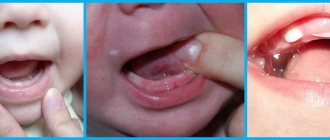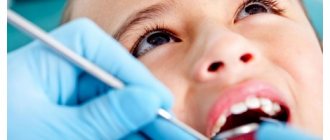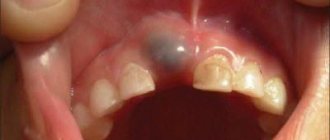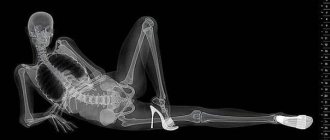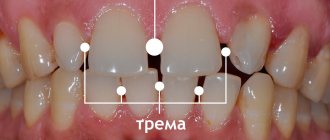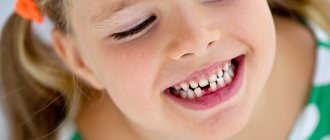Popular types of x-rays of baby teeth in children
Modern pediatric dentistry allows us to solve any problems with baby teeth. But in order to consider the disease and make a correct diagnosis, it is not enough just the child’s complaints and his description of pain and discomfort. In order for treatment to be as effective as possible, it is necessary to build a treatment plan based on diagnostic data that can be obtained after one of four popular types of radiography:
- Sighting (periapical). Indicated in cases where clarification is necessary on one or more adjacent teeth (from 1 to 3). Provides data about the units themselves, their roots and surrounding soft tissues.
- Occlusal (palatal). As a result, the attending physician receives a complete projection of one of the child’s jaws. The technique is used to determine possible malocclusions and anomalies of the dentition in general.
- Panoramic (orthopantomogram). Allows scanning of the entire oral cavity. An orthopantomogram for children is indicated for a detailed study of pathologies of the upper and lower jaw, the temporomandibular joint and the maxillary sinuses. The results of such an x-ray are necessary for further dental correction. This type of examination is prescribed for children with a fully formed dental system, that is, from about 9 years old.
- 3D pictures. A three-dimensional X-ray image of children's primary teeth allows us to obtain data on all units (existing and not yet erupted). The entire maxillofacial area is subject to examination. The photographs can be used to evaluate the structure of the entire skeletal system of the jaws, the condition of the root system (including pathologies), inflammation in soft tissues, etc. Such dental x-rays are prescribed for the purpose of making a diagnosis and as a control study after canal filling.
Depending on the existing problems with baby teeth, the child may be prescribed one specific or several different types of examination. The attending physician will definitely explain the advisability of obtaining images and the need for x-rays.
You might be interested in:
Dental diagnostics
Pediatric orthopantomogram
3D image of teeth
Types of X-rays of children's teeth
- Sight shot
- allows you to “enlighten” one or two adjacent teeth and see its detailed condition, as well as the condition of the surrounding soft tissues.
- Panoramic shot
(or, in other words, orthopantomogram) - displays a complete picture of the jaw and dentition, allows you to see not only baby teeth, but also all the rudiments of permanent ones. A panoramic photograph of a child’s teeth is taken during the period of active eruption of permanent teeth or before the start of orthodontic treatment.
When is a child's dental x-ray prescribed?
It is important for parents to understand in what cases it is necessary to take an x-ray of children’s baby teeth. Detailed diagnostics may be required in a variety of cases (depending on the individual characteristics of the structure and development of the dental system). Most often, radiographic examinations are prescribed in the following cases:
- To identify deep caries. Milk teeth, unlike permanent teeth, have more fragile enamel. Consequently, they are more susceptible to exposure to aggressive substances that enter the mouth with food. Carbonated drinks, fast food, sweets - all this causes the appearance of caries, which is not always noticeable upon visual inspection. At routine visits to the dentist, with x-rays, you can verify the absence or confirm the presence of deep caries.
- To study abnormalities in the development of teeth and jaws. If a child has problems with teething, abnormal growth, or pain when closing the jaws, this may be a reason to take an X-ray of the children’s baby teeth. The results will allow us to study the existing problems in detail and intervene in a timely manner, solving issues of delayed growth of units and many others.
- To monitor the condition of permanent teeth. Not only baby teeth, but also permanent children’s teeth require special attention even before they appear. Studying the rudiments allows not only to determine possible anomalies, but also to make predictions about the timing of eruption.
- Bite study. An incorrect bite can cause premature tooth wear and the appearance of various pathologies. An X-ray of a child’s teeth can provide detailed data on the position of the jaws in order to identify even the slightest deviations from the norm.
- Detection of abscesses. Inflammatory processes in the initial stages may be asymptomatic. An advanced abscess can cause serious operations, including surgical ones. At the same time, x-rays can show foci of inflammation and begin treatment on time.
Some children are so mobile and active that they often get injured, including in the jaw. Serious injuries may be visible during visual inspection, and some cracks and misalignments can only be diagnosed after X-raying the child's teeth.
Features of baby teeth
The structure of baby teeth is similar to permanent teeth: in the jaw there are such types of teeth as incisors, canines, premolars and molars - all like in adults. Only their number differs: for children – 20, for adults – 32.
Baby teeth are formed in the sixth week while still in the womb. After the birth of a child, teeth erupt at about 6 months and grow in by 3-4 years. The exact age depends on the individual's rate of development.
However, there are some differences from permanent teeth:
- baby teeth have long roots that are easily absorbed over time
- greater distance between teeth - so that falling out for replacement is easy
- thinner and more delicate enamel
- softer dentin and surrounding tissues
Answers to frequently asked questions about x-rays of baby teeth in children
We offer expert answers from specialists from the Smile Factor network of clinics to frequently asked questions by parents.
Can an x-ray be prescribed to a child “just in case”?
Unfounded medical (and dental) research is prohibited by SanPiN.
But, most often, diagnosis according to indications is at the discretion of the attending physician. Any parent can ask clarifying questions and learn more about the assigned test and what it is for. What is better - 2D or 3D scanning result?
It all depends on the goals of the diagnosis.
In some cases, a 2D image is sufficient, while in others a CBCT scan is required to obtain a 3D image. Taking into account how CT scans of the jaw and teeth are done, the procedure is not much different from a simple x-ray in terms of safety and is indicated for obtaining more extensive data about the child’s dental system in the images. Are x-rays harmful to a child?
Modern X-ray machines (and most often these are ultra-modern tomographs) produce the minimum possible radiation dose during operation, which does not cause any harm to the child’s body. To achieve the maximum recommended radiation exposure of 1000 µSv per year, a child needs to undergo about 400 x-ray examinations. It becomes clear that so much research is simply not needed. And the radiation that a baby receives during a CT scan is equal to what he receives after a week of watching TV.
How is a dental x-ray performed?
An X-ray of a child’s jaw with baby teeth is a painless procedure that takes 3 to 5 minutes.
The course of dental radiography in children consists of:
- the pediatric dentist gives a referral for examination;
- the child, with or without a parent, is sent to a special room;
- a special apron with lead plates is put on him;
- clamps a plastic plate with his teeth;
- the specialist fixes the position of the head and leaves the room;
- The device turns on and takes a photo.
If there is a need for a targeted X-ray, the child is seated on a chair, a film is placed in the mouth, and an X-ray tube is placed near the mouth and held for several seconds. During the procedure, the child must sit still, otherwise the images may be distorted.
The results are delivered in 20–30 minutes. With the received images, the patient is sent to the attending physician. You can get an X-ray of a child in Moscow at the Novodent dental clinic. There is advanced and modern equipment with minimal radiation doses, but high information content. There are doctors who will find an approach to every little patient, inspire trust, and listen to their recommendations. More detailed information about the clinic’s capabilities can be found on the website or by phone.
Read also
What to do if your tooth aches
Sometimes aching pain in a tooth can appear for no apparent reason at first glance.
Why do teeth crumble?
Tooth decay in general, and crumbling in particular, is not an aesthetic problem.
Everything you wanted to know about dental x-rays for children
X-ray is a fairly serious procedure. Therefore, many parents are concerned about its safety for children and cases when they really cannot do without it. Our dentist will answer the most important of these questions.
Are x-rays safe for dental treatment?
“Zubrenok” uses modern X-ray equipment from a leading global manufacturer, so you can safely agree to have your child x-rayed. The baby's health will not suffer from this at all. To obtain an X-ray of baby teeth (even repeated ones), minimal doses of radiation are required.
What dose of radiation do I consider acceptable for a child? Is it really harmless to health?
The legislation sets maximum standards for human exposure per year. If they are followed, the child’s body will not be harmed. To obtain such a radiation rate, you will have to be examined with a visiograph 400 times a year, examined with a CT scan 20 times over the same period, and panoramic digital photographs taken 80 times. When treating primary teeth, no qualified dentist will need such a number of x-rays. When contacting Zubryonok, rest assured that our doctor will prescribe exactly as many procedures as are really necessary.
At what age can children have X-rays taken?
X-ray diagnostics are officially approved even for newborns. in this case, the maximum dosage will be the same as for an adult (1000 μSv per year).
What types of dental X-ray examinations are carried out at Zubrenok?
Our dentists can refer your child for the following types of x-ray examinations:
- OPTG (stands for “orthopantomogram”). During one procedure, the patient receives radiation of about 40 μSv;
- a targeted image, for which the patient will receive a small amount of radiation. 1-2 teeth – up to 5 µSv. This procedure can be performed by people of any age without restrictions.
Why is a targeted photo taken and what does it show?
In our pediatric dentistry clinic, targeted images are taken using a high-precision visiograph, which guarantees minimal radiation exposure. The dentist may refer you for this procedure to obtain detailed information about the condition of one or more primary teeth.
On a targeted x-ray you can see:
- what kind of caries (deep or medium) the tooth is affected by;
- what exactly develops in a small patient – periodontitis or pulpitis;
- hidden cavities affected by caries that cannot be detected during a routine examination;
- how well the root canals were filled (if the child already has permanent teeth).
What is OPTG, what are its features and advantages?
Unlike a conventional x-ray, an orthopantomogram allows dentists of various specializations (general practitioners, orthodontists, surgeons) to assess the condition of the dental system as a whole, identify wisdom teeth, impacted and supernumerary teeth, the condition of bone tissue, etc. This information is necessary to understand the causes of dental anomalies and draw up a treatment plan.
Can X-rays be prescribed “just in case”?
The Zubryonok Pediatric Dentistry Clinic strictly adheres to current legislation in its activities. SanPin prohibits unreasonably sending for x-rays and our dentists know this. To prescribe an x-ray for diagnostic purposes there must be reasons and clinical indications.
If you have any questions, we will be happy to answer them. Enroll your child in “Zubrenok” to preserve the health and beauty of his teeth!

